Plymouth, Devon
Up to 1834
Plymouth's first workhouse, on Catherine Street, was founded by the town corporation in 1615 as the "Hospital of the Poor's Portion". In 1707-8, its operation was handed over to a body of Guardians, incorporated by a local Act of Parliament, which allowed the two parishes of Plymouth St Andrew and Plymouth Charles the Martyr to unite for the purposes of poor-law administration, including the operation of a residential workhouse. The Incorporation was managed by a body called the Guardians of the Poor which comprised the city's Mayor, Recorder, six of its magistrates, six members of the common council, twenty inhabitants of the parish of St Andrew, and 18 inhabitants of the parish of Charles the Martyr. The Incorporation took over the Catherine Street workhouse. Part of the site was then allocated for use as the Dock Gaol.
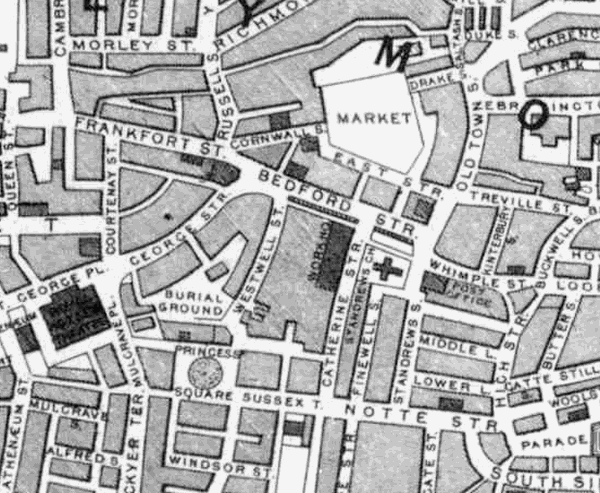
Plymouth workhouse site, 1851.
The Guardians records include some interesting items. In 1731, Mr. Peter Whipple was contracted "to shave the poor men of this House once a Fortnight for a penny a time for each person, and to poll the Boys for Sixpence a Quarter." In trhe same year, it was ordered that the out poor shall wear badges. In 1758, a building was ordered to be erected for a Pound for beating Hemp, with a large Moorstone like that used for bruising apples, and all other things convenient for that purpose. On 27 August 1787, it was ordered "that Players be requested to Act a Play for the benefit of the Poor." In 1814, the building was much enlarged. In 1827, the eastern side of the quadrangle was rebuilt, at a cost of £1058, and in 1833 was again considerably extended. An Act of 1813, among other provisions, declared the House of Correction within the Workhouse available for lunatics and for other purposes.
After 1834
Plymouth Incorporation's local Act status exempted it from most of the provisions of the 1834 Poor Law Amendment Act and the Incorporation continued in operation until 1930, when the Plymouth Council took over the administration of poor relief in the city.
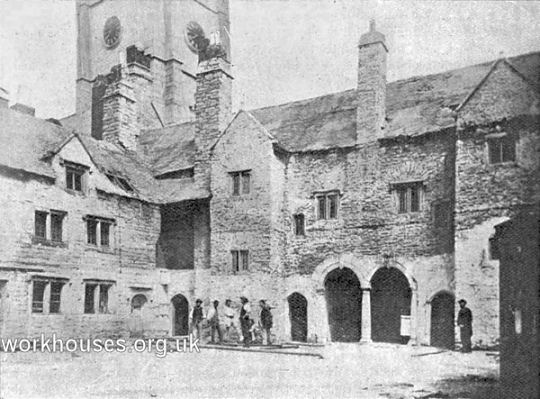
Interior of Catherine Street workhouse, Plymouth.
In the summer of 1849, there was a major outbreak of cholera in the city. The Incorporation workhouse in Catherine Street could not cope — it was overcrowded, badly ventilated, had only one bath and little hot water. In the same year, there was a scandal in the local newspaper concerning the undignified treatment of a the body of the Mrs Henrietta Beer who had died in the workhouse. The Incorporation's Board of Guardians decided that the old workhouse needed to be replaced. Land had already been earmarked for such a scheme on a four-acre site at Specott's Fields near Freedom Park near the recently erected Borough Prisons.
On 16th March 1852, the foundation stone was laid for a new building at Longfield Place. Designed by Arthur and Dwelly, and accommodating between six and seven hundred inmates, it was eventually completed in 1858 at a cost of £12,500. Its location and layout are shown on the 1860 map below:
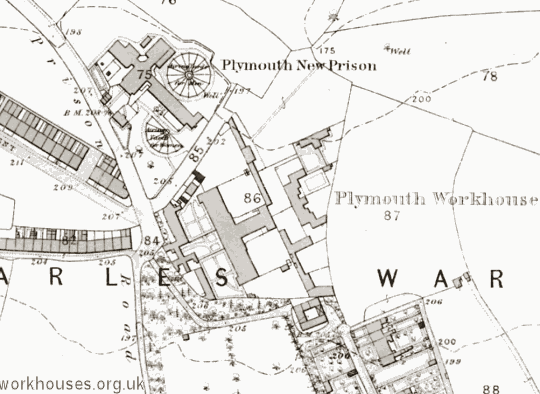
Plymouth workhouse site, 1860.
At the west of the site, at the junction of Longfield Place and Greenbank Road was a building latterly known as Greenbank House which may have contained the Guardians' offices. The main workhouse building was a three-storey structure at the centre of the site.
The workhouse had very extensive gardens in which the inmates cultivated vegetables which on one occasion amounted to 20,000 leeks and 11,000 cabbages.
On 28 April 1871, an inmate of the workhouse committed suicide by throwing himself from a window of the building.
In 1894, the British Medical Journal set up a "commission" to investigate conditions in provincial workhouses and their infirmaries. Following a visit to Plymouth, the commission's report found much to criticise about the workhouse infirmary. The wards were small and numerous and spread over three floors; the staircases were steep, and the passages narrow. No piped hot water was laid on — it had to be carried in buckets from a sunken hot-water tank in one of the courtyards, described by the reports as "a very dangerous and unsatisfactory contrivance". The labour ward was the first floor in the main part of the workhouse; it was small, lacked privacy and, when going into labour, women had to climb up the stairs from the ward below. Two nurses were employed, of whom only one was formally trained. They were assisted by pauper inmates who also provided the only night-time cover. The commission recommended the building of a new infirmary and a doubling of the nursing staff, with trained nurses being employed during the night. Further details are available in the full report.
Subsequently, in November 1894, the British Medical Journal reported that:
In September 1895, the Board of Guardians had received a letter from a gentleman at Torquay, inquiring whether the guardians would assist him in finding a wife. He stated that he wanted a woman between twenty-four and thirty years of age, slim and passably good-looking, but he did not care what her religious creed was, so long as she was respectable. The letter concluded, 'Please grant me permission to go over the workhouse on any visiting day and select a wife for myself. It will be one woman less on the rates of Plymouth, my native town. I will leave the matter in your hands, as I would rather have a poor woman from the workhouse than one who required no sympathy.' The letter was referred to the chairman of the House Committee.
On 5 JuLy 1907, an early morning fire caused serious damage to a three-storey block occupied by 300 men and women. All of the inmates, many of whom were old and feeble, were safely evacuated. Some, however, had to escape in their night attire and suffered severely from exposure as the weather was very cold and the ground wet from recent rain. The fire, which originated in a store on the top floor, destroyed the roof of the building and burnt out the upper dormitories. The guardians were left facing the difficulty of obtaining temporary accommodation for the inmates.
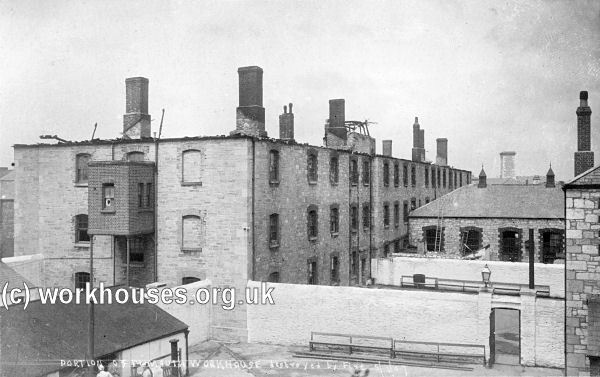
Plymouth workhouse from the south-east following the 1907 fire.
© Peter Higginbotham.
A variety of other buildings were subsequently added to the workhouse site including an isolation/smallpox hospital, venereal ward block and maternity block. In 1907-10 a major development of hospital facilities took place to the east of the workhouse with the erection of two large ward blocks, an administration block and a nurses' home. The latter accommodated 21 nurses and included a special room for the storage of bicycles.
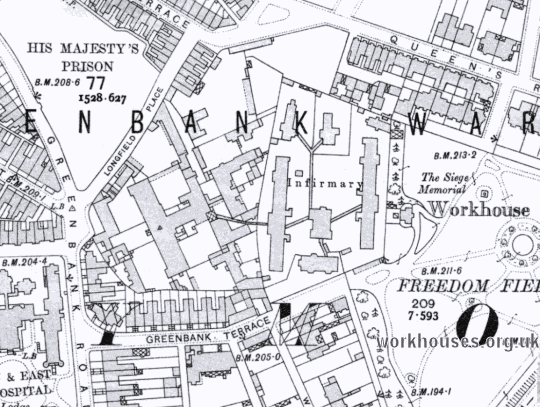
Plymouth workhouse site, c.1914.
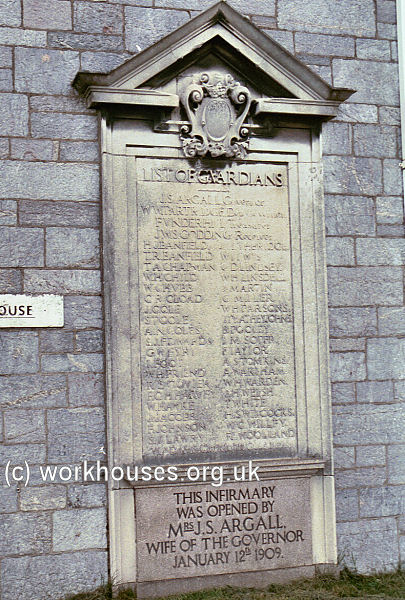
Plymouth workhouse infirmary foundation plaque, 2001.
© Peter Higginbotham.
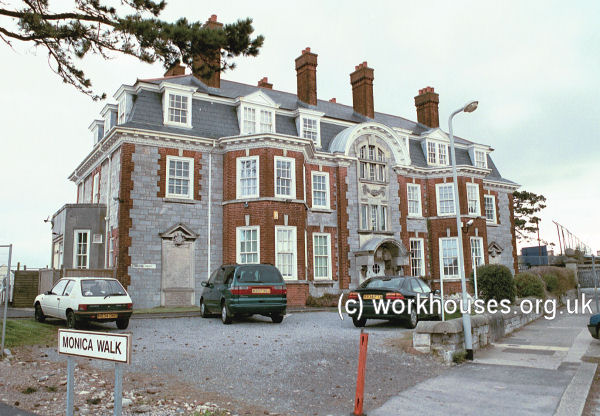
Plymouth workhouse nurses' home, 2001.
© Peter Higginbotham.
From 1909 to 1929, the hospital facility was known as Greenbank Infirmary. In 1930 the site became known as Plymouth City (General) Hospital. Within a few years, all of the city's hospitals were amalgamated under the umbrella name of the Prince of Wales Hospital. In 1951, shortly after the inauguration of the National Health Service, the former workhouse site became Freedom Fields Hospital.
7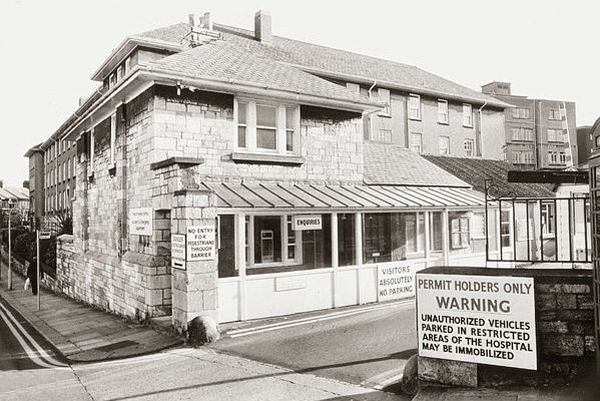
Freedom Fields Hospital entrance.
The site was redeveloped as a housing estate in 2000 and virtually all the hospital buildings have now been demolished.
Plymouth Scattered Homes
The Plymouth Incorporation provided accommodation for pauper children in a number of scattered homes. These included:
- 55 and 168 Alexandra Road
- 6 Ashford Road
- 19 Egerton Road
- 20 Channel View Terrace
- 80 Mount Gold Road
- 36 Hill Park Crescent
- 5 Saltram Villas, Laira
- 2 Gifford Terrace, Mutley
- Southern Villa, Park Road, Compton
- Priory House, Priory Lawn Terrace, Lower Compton
A Central Home at 13 Hill Park Crescent administered the system and processed new arrivals.
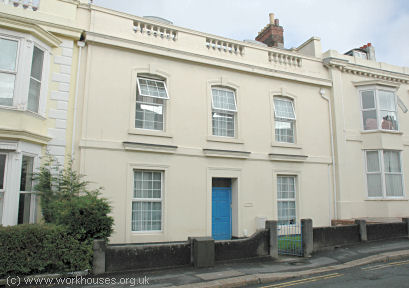
Central Home at 13 Hill Park Crescent, 2005.
© Peter Higginbotham.
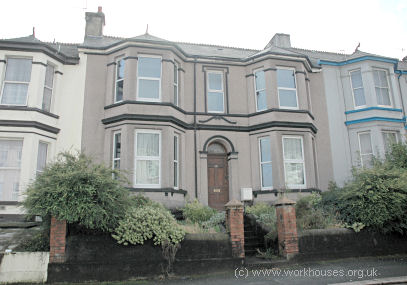
Scattered Home at 168 Alexandra Road, 2005.
© Peter Higginbotham.
Staff
Inmates
Records
Note: many repositories impose a closure period of up to 100 years for records identifying individuals. Before travelling a long distance, always check that the records you want to consult will be available.
- Plymouth and West Devon Record Office, The Box, Tavistock Place, Plymouth, Devon PL4 8AX. Most of local records were destroyed by enemy bombing in 1941. Holdings include: Board and Committee minutes (1909-1930); Poor Law Board and Local Government Board correspondence 1851-19145.
Bibliography
- None.
Links
Unless otherwise indicated, this page () is copyright Peter Higginbotham. Contents may not be reproduced without permission.


